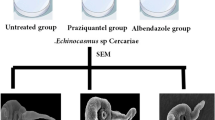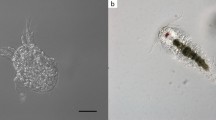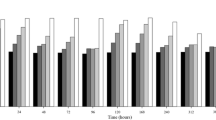Abstract
Trigger and toxic effects of Mytilus edulis (Bivalvia) hemolymph on encystment of cercariae Himasthla elongata obtained from infestated Littorina littorea (Prosobranchia) was evaluated as a result of 24-h experiments in vitro. The contact of H. elongata larvae with the whole hemolymph or mussel acellular plasma led to an intensive transformation of cercariae into metacercariae. In both tested media, the cercariae had to complete the encystment phase as fast as for 2 h, otherwise the risk of the larvae injury by humoral and cellular components of the mussel hemolymph would increase dramatically. The cercaria mortality after 24 h in the whole hemolymph was twice higher than in plasma (40% and 20%, respectively) and much higher than in the control medium (sea water). Both toxic and trigger effects of plasma was revealed to depend on its concentration, with the maximal larva mortality in the undiluted medium and with the highest number of successful transformations in the medium diluted more than 4 times. There is shown both the strong individual variability of toxicity of the individual mussel hemolymph for cercariae and the variability of the resistance to the toxic factors of the cercariae obtained from various L. littorea individuals. These experiments not only offer a method of the massive encystment of H. elongata cercariae, but also propose a perspective model for the study of the systemic defensive response of Bivalvia to invasion of multicellular parasite.
Similar content being viewed by others
REFERENCES
Write, C.A., The Pathogenesis of Helminthes in the Mollusca, Helminthol. Abstr., 1971, vol. 35, pp. 207–224.
Gorbushin, A.M., Comparative Morpho-Functional Analysis of the Gastropod—Trematode Interactions, Parazitologiya, 2000, vol. 34, pp. 502–514.
Haas, W., Gui, B., Haberl, M., and Strobel, M., Miracidia of Schistosoma japonicum: Approach and Attachment to the Snail Host, J. Parasitol., 1991, vol. 77, pp. 509–513.
Kalbe, M., Haberl, B., and Haas, W., Snail Host Finding by Fasciola hepatica and Trichobilharzia ocellata: Compound Analysis of “Miracidia-Attract-mg Glycoproteins”, J. Parasitol., 2000, vol. 96, pp. 231–242.
Bayne, C., Humoral Factors in Molluscan Parasite Immunity, Aspects of Developmental and Comparative Immunology, Solomon, J., Ed., Oxford: Pergamon, 1980, vol. 1, pp. 113–124.
Adema, C.M. and Loker, E.S., Specificity and Immunobiology of Larval Digenean—Snail Associations, Advances in Trematode Biology, Fried, B. and Graczyk, T.K., Eds., Roca Raton: CRC, 1997, pp. 230–253.
Yoshino, T.P. and Vasta, G.R., Parasite—Invertebrate Host Immune Interactions, Advances in Comparative and Environmental Physiology, Cooper, T., Ed., Berlin: Springer, 1996, pp. 125–167.
Laursen, J.R. and Yoshino, T.P., Biomphalaria glabrata Embryonic (Bge) Cell Line Supports in vitro Miracidial Transformation and Early Larval Development of the Deer Liver Fluke, Fascioloides magna, Parasitol., 1999, vol. 118, pp. 187–194.
Coustau, C. and Yoshino, T.P., Flukes without Snails: Advances in the in vitro Cultivation of Intramolluscan Stages of Trematodes, Exper. Parasitol., 2000, vol. 94, pp. 62–66.
Sapp, K.K. and Loker, E.S., Mechanisms Underlying Digenean—Snail Specificity: Role of Miracidial Attachment and Host Plasma Factors, J. Parasitol., 2000, vol. 86, pp. 1012–1019.
Gibson, D.I. and Bray, R.A., The Evolutionary Expansion and the Host—Parasite Relationships of the Digenea, Intern. J. Parasitol., 1994, vol. 77, pp. 798–800.
Yakovleva, N.V., Samoilovich, M.P., and Gorbushin, A.M., The Diversity of Strategies of Defense from Pathogens in Molluscs, J. Evol. Biochem. Physiol., 2001, vol. 37, pp. 358–367.
Werding, B., Morphologie, Entwicklung und Okologie Digener Trematogen-larven der Strandschnecke Littorina littorea, Marine Biol., 1969, vol. 3, pp. 306–333.
Zhivotovskii, L.A., Populyatsionnaya biometriya (Populational Biometry), Moscow, 1991.
Freied, B., Frazer, B.A., and Reddy, A., Chemoattraction and Penetration of Echinostoma trivolvis and E. caproni cercariae in the Presence of Biomphalaria glabrata, Helisoma trivolvis and Lymnaea elodes Dialysate, Parasitol. Res., 1997, vol. 83, pp. 193–197.
Haas, W., Korner, M., Hutterer, E., Wegner, M., and Haberl, B., Finding and Recognition of the Snail Intermediate Hosts by 3 Species of Echinostome Cercariae, Parasitol., 1995, vol. 110 (Pt 2), pp. 133–142.
Korner, M. and Haas, W., Chemo-Orientation of Echinostome Cercariae towards Their Snail Hosts: Amino Acids Signal a Low Host-Specificity, Int. J. Parasitol., 1998, vol. 28, pp. 511–516.
Korner, M. and Haas, W., Chemo-Orientation of Echinostome Cercariae towards Their Snail Hosts: Amino Acids Signal a Low Host-Specificity, Int. J. Parasitol., 1998, vol. 28, pp. 517–525.
Fateev, A.E., Granovitch, A.I., and Slusarev, G.S., Comparative Analysis of Symbiotic Fauna in Mytilus edulis from Natural and Industrial Populations in Kandalaksha Bay, Experience of Iindustrial Farming of Blue Mussel in the White Sea (Trudy Biologiches kogo Nauchno-Issledovatelskogo Instituta SPbGU), Minichev, Yu.S. and Maksimovitch, N.V., Eds., St. Petersburg: St. Petersburg State University, 2000, vol. 46, pp. 155–172.
Dyrynda, E.A., Pipe, R.K., and Ratcliffe, N.A., Sub-Populations of Haemocytes in the Adult and Developing Marine Mussel, Mytilus edulis, Identified by Use of Monoclonal Antibodies, Cell Tissue Res., 1997, vol. 289, pp. 527–536.
Pipe, R.K., Farley, S.R., and Coles, J.A., The Separation and Characterization of Haemocytes from the Mussel Mytilus edulis, Cell Tissue Res., 1997, vol. 289, pp. 537–545.
Pipe, R.K., Hydrolytic Enzymes Associated with the Granular Haemocytes of the Marine Mussel Mytilus edulis, Histochem. J., 1990, vol. 22, pp. 595–603.
Winston, G.W., Moore, M.N., Kirchin, M.A., and Soverchia, C., Production of Reactive Oxygen Species by Hemocytes from the Marine Mussel, Mytilus edulis: Lysosomal Localization and Effect of Xenobiotics, Comp. Biochem. Physiol., 1996, vol. 113, pp. 221–229.
Wittke, M. and Renwrantz, L., Quantification of Cytotoxic Hemocytes of Mytilus edulis Using a Cytotoxicity Assay in Agar, J. Invertebr. Pathol., 1984, vol. 43, pp. 248–253.
Leippe, M. and Renwrantz, L., Release of Cytotoxic and Agglutinating Molecules by Mytilus Hemocytes, Dev. Comp. Immunol., 1988, vol. 12, pp. 297–308.
Horak, P. and van der Knaap, W.P.W., Lectins in Snail–Trematode Interactions: A Review, Fol. Parasitol., 1997, vol. 44, pp. 161–172.
Mullainadhan, P. and Renwrantz, L., Lectin-Dependent Recognition of Foreign Cells by Hemocytes of the Mussel, Mytilus edulis, Immunobiol., 1986, vol. 171, pp. 263–273.
Renwrantz, L., Daniels, J., and Hansen, P.D., Lectin-Binding to Hemocytes of Mytilus edulis, Dev. Comp. Immunol., 1985, vol. 9, pp. 203–210.
Hubert, F., Cooper, E.L., and Roch, P., Structure and Differential Target Sensitivity of the Stimulable Cytotoxic Complex from Hemolymph of the Mediterranean Mussel Mytilus galloprovincialis, Biochim. Biophys. Acta, 1997, vol. 1361, pp. 29–41.
Author information
Authors and Affiliations
Additional information
__________
Translated from Zhurnal Evolyutsionnoi Biokhimii i Fiziologii, Vol. 41, No. 4, 2005, pp. 343–349.
Original Russian Text Copyright © 2005 by Gorbushin, Levakin.
Rights and permissions
About this article
Cite this article
Gorbushin, A.M., Levakin, I.A. Encystment in vitro of the Cercariae Himasthla elongata (Trematoda: Echinostomatidae). J Evol Biochem Phys 41, 428–436 (2005). https://doi.org/10.1007/s10893-005-0079-2
Received:
Issue Date:
DOI: https://doi.org/10.1007/s10893-005-0079-2




